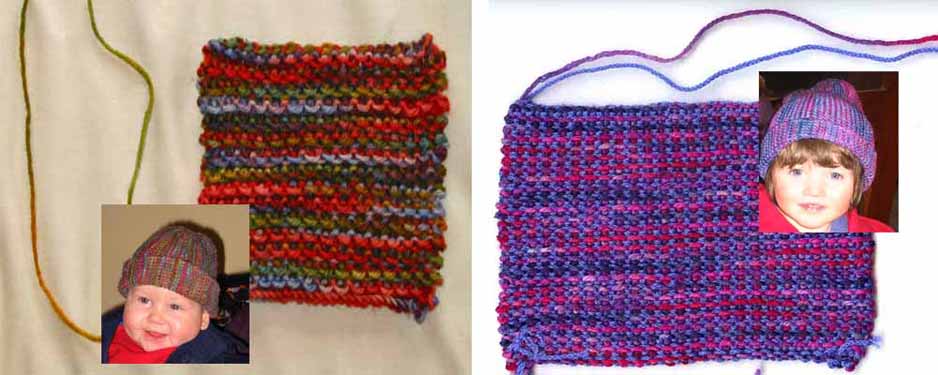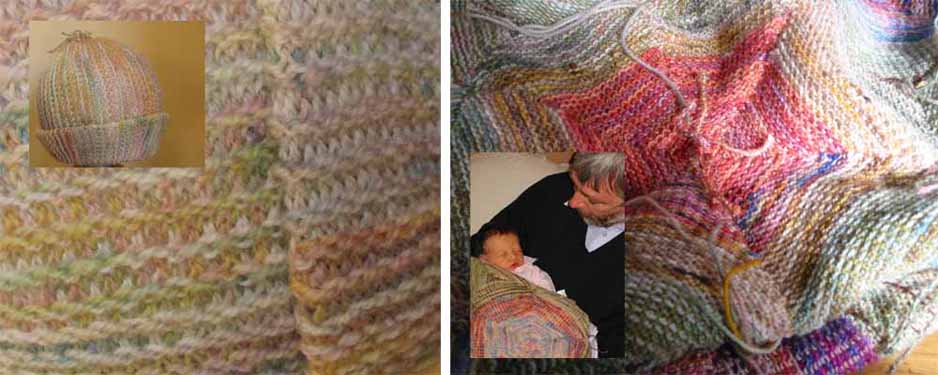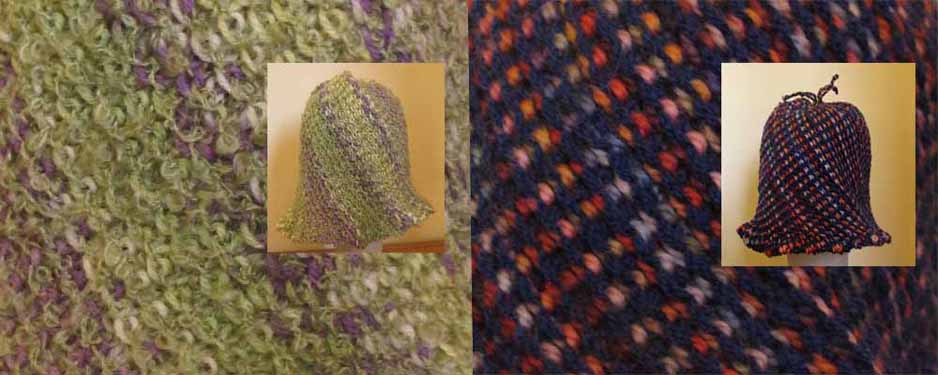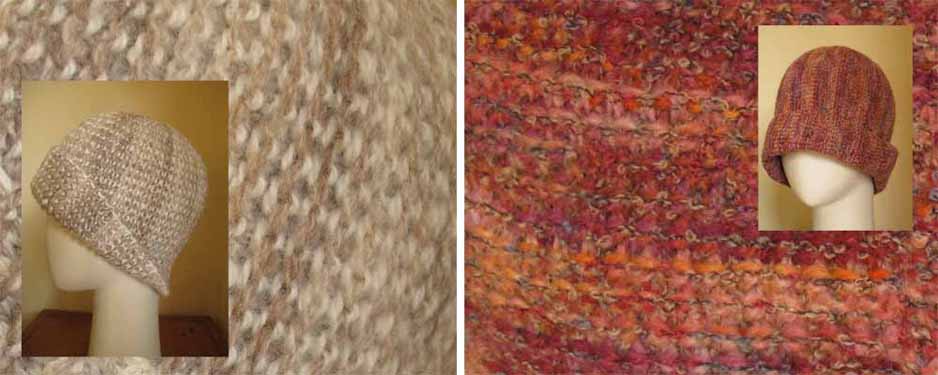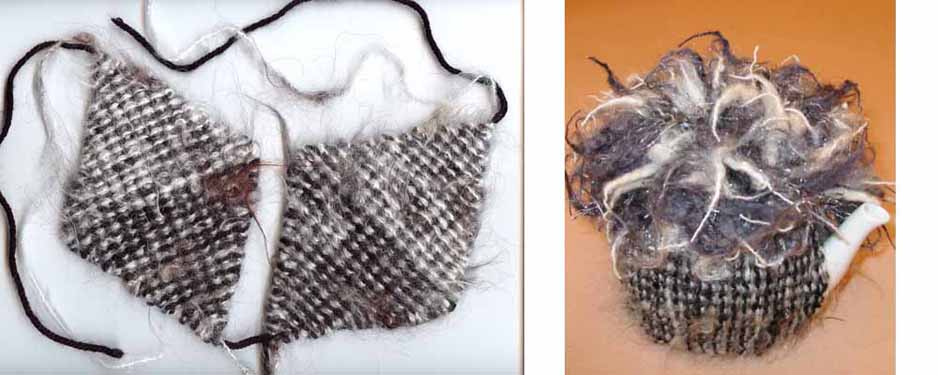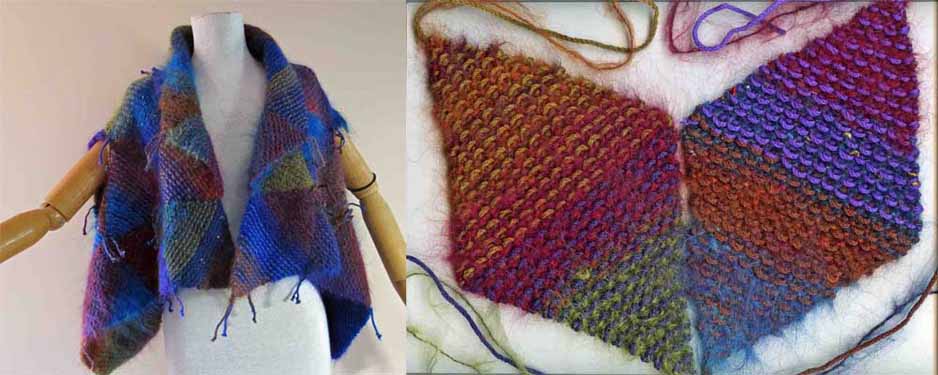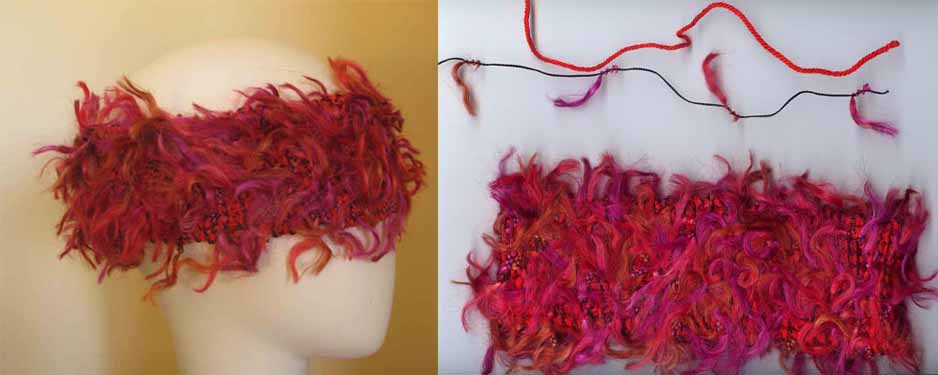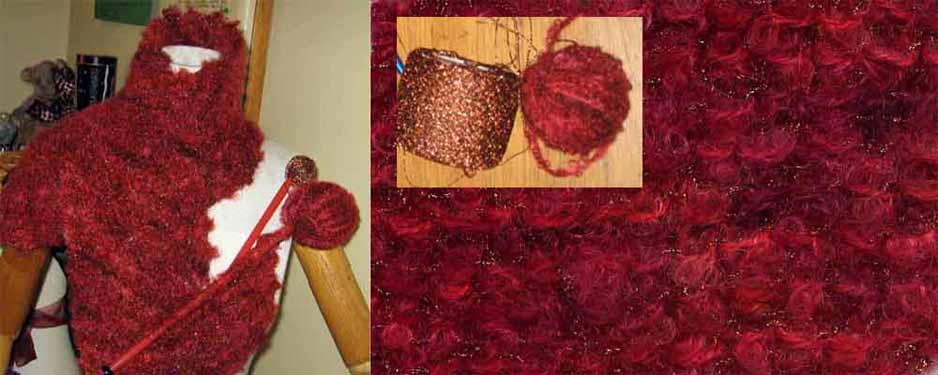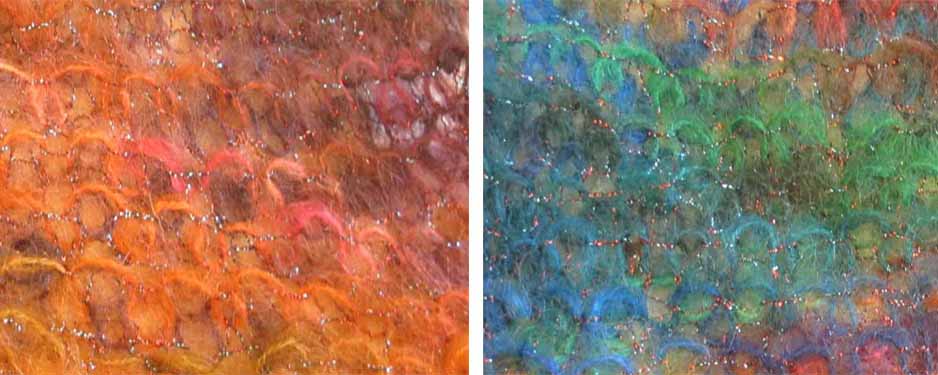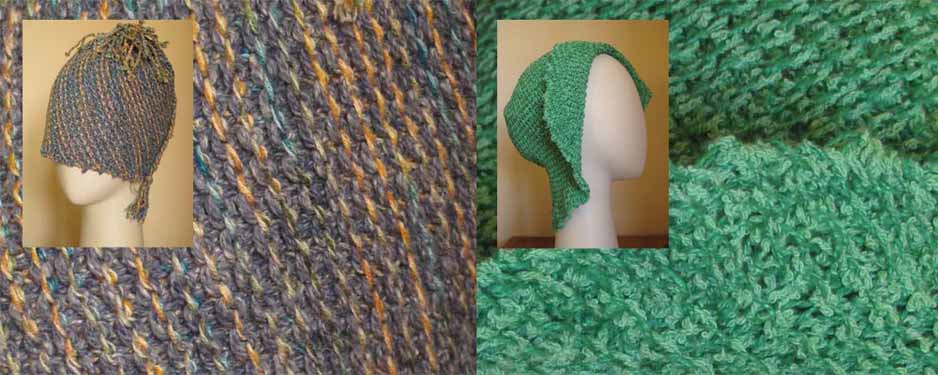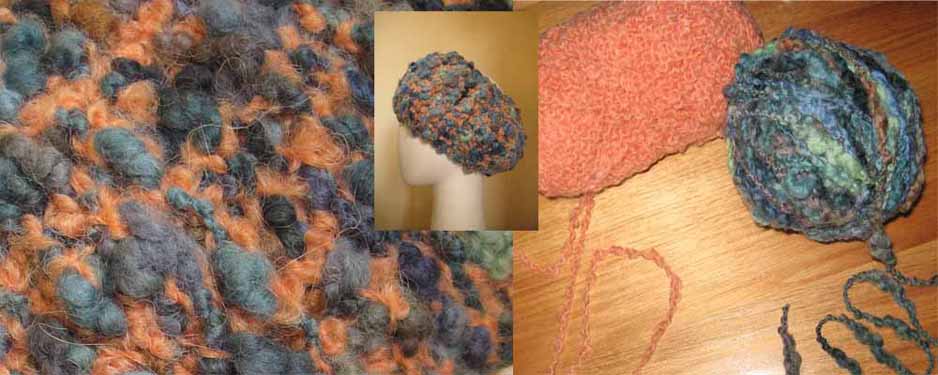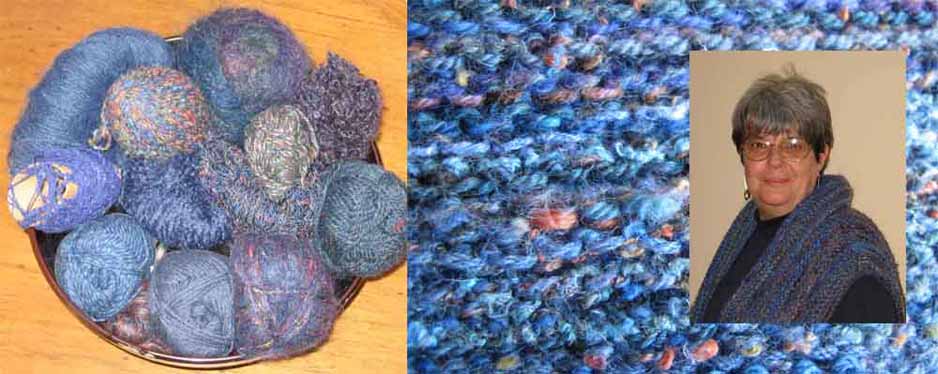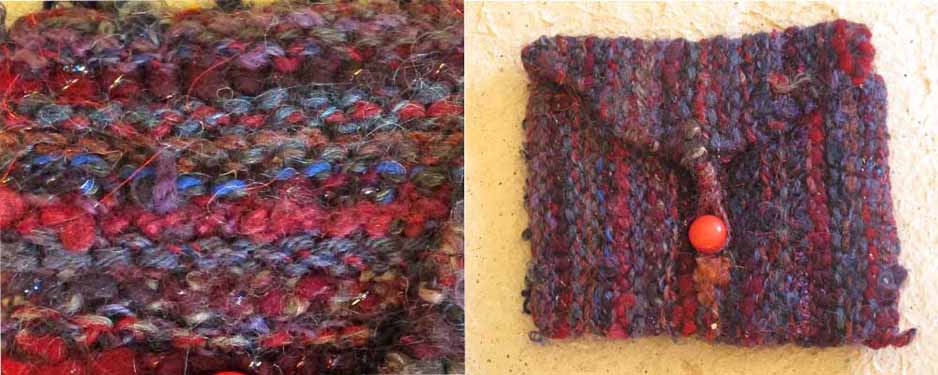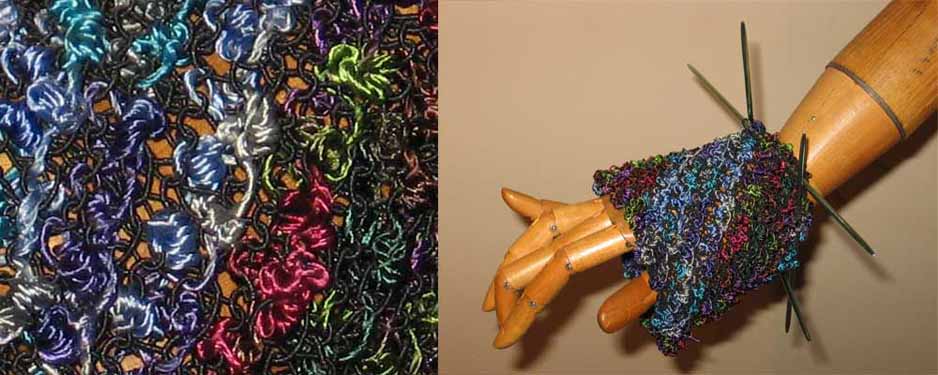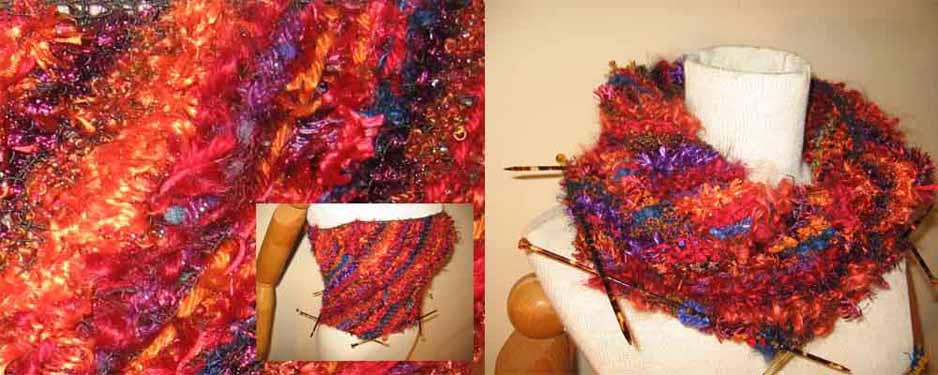Woven Garter stitch makes a wide range of knitted fabrics possible. Yarns of different types and weights with different size needles can produce fabrics that are fine and drapey to thick and sturdy, multi-coloured to subtley shaded, smooth and filmey to deliciously heavily textured.
I frequently use a textured yarn as Yarn A and a smooth one as Yarn B. Then change them over. Two smooth yarns go well together too giving much scope for fun with colour and contrast.
Sometimes an honest [but perhaps not all that exciting] 8ply/DK as Yarn B can be just the vehicle for a colourful mohair loop Yarn A. Left over school jumper grey wool proved so once.
Check out the slide show on the right and below are the details of some of the yarns and fabrics that I’ve experimented with in various projects in the last ten years or so.
SMOOTH YARNS MAINLY
These Fold’nRolled beanies are a good weight for littlies. Nick’s on the left was made with two balls of the same hand painted yarn – it was sock weight. Using two balls of the same hand painted yarn gives an interesting integrated coloured fabric.
Clare’s beanie on the right was made with a plain 4ply blue crepe Yarn B and a hand painted Yarn A to good effect. Pattern guidelines for these and most of the other samples will be found via the WG Project links when they are completed.
Another Fold’nRolled beanie on the left, made again with two balls of the same 4ply pastel wool. Clare’s Shawl on the right was made with sock yarns and some pastel 4plys variously as Yarns A and B. I made hexagons from kite shaped diamonds then stitched them together. This design is in the WG Project section too.
Both these hats have colourful Yarn Bs and plain coloured Yarn As. Yarn B on the left was a gentle sock yarn and Yarn A a pale green lace weight boucle. It enhanced the effect of the sock yarn. Yarn B on the right was a very bright 4ply hand painted yarn and Yarn A a plain navy 4ply. I like the way a dark Yarn A allows a bright Yarn B to peep out – a bit like confetti.
These two samples demonstrate the diversity and elegance of the stitch. The yarns used for the hat on the left were 8ply/DK natural merino wool – Yarn B was white and Yarn A featured variable light browns and greys. The hat on the right – an adult version of the Fold’nRolled design – was much lighter and took much longer to knit – the effort was worth it. Yarn B was a lace weight hand painted wool in sunset shades and Yarn A a lace weight boucle in light greys and browns. The knitted fabric was filmy and suggested itself as being just right for light weight cardigans, scarves, shawls and such as well.
SMOOTH and TEXTURED YARNS
Several things to note here. The two diamonds on the left and the base of the tea cosy were made with the same yarns – a black crepe 8ply/DK yarn and a mostly white 12ish ply mohair with the occasional dark brown and light grey flourish. The mohair was Yarn B for the tea cosy base and for the bottom half of each of the diamonds. Not hard to see how it is dominated by the black Yarn A on these occasions. For the top half of the diamonds the white mohair was in charge as Yarn A.
You can see that if I had made six of these diamonds and stitched them together there’d have been a black-ish hexagonal centre of a rather striking star. WARNING: Ignore the next paragraph if you’re not interested in reading about how geometry seems to have been invented in the service of knitters!
The geometry of Woven Garter can be lots of fun. Because it is basically garter stitch and features stranding two yarns, the stitches are narrower than they are in stocking stitch. Sometimes, as in these diamonds above, the stitches are almost square and the sides of each diamond measure the same as the widest part of the diamond.
Now, back to the yarns here, especially those on the top of the tea cosy. At the same time as I’d found the white-ish mohair yarn for this project there was a delicious yarn around with regular and generously thick and thin portions. It came in various colour combinations but I was especially taken by the black and white at that stage. I cut it in lengths and knitted it in with a carrier yarn for the top of the cosy using a stitch I called Shaggy Reverse Stocking Stitch. There’s an explanation of the stitch in the 2014 December issue of Yarn Magazine. In time it will also be explained and featured on this site.
More diamonds, more mohair, and more 8ply/DK crepe yarns. This project is featured in Yarn Magazine [Issue 33] and also highlights the delights of geometrical knitting. You don’t have to understand the ‘how’, just how and when to apply the ‘what’!
In these diamonds Yarn B was always one of the 12ish ply mohairs I had in one basket. Another basket had a supply of 8ply/DK wool crepes ready for Yarn A duty.
This jacket has two versions – this way, and the other way up. In this version you’ll notice the drape of the collar – in the other version the same part becomes the hemline.
Hats again. Hats are a great way to sample new yarns in combination. The one on the right was a Fold’nRolled project in Jenny Dowde’s first Freeform knitting and crochet book in early in the 2000s. Yarn A was a multi-coloured mohair loop. Originally I’d used a hand painted 4ply smooth yarn of similar colour tones but the resulting fabric was a bit lifeless – dull even. So I changed to a similar yarn in ‘baby’ colours – mostly pink, blue and lemon. You can see some of the blue section in the picture. When I held the baby yarn together with the mohair loop they certainly didn’t ‘go’ with each other. But I forged ahead and was delighted with the result. It was as if the lighter, brighter Yarn B was throwing light up through the mohair loop. My weaving friends weren’t at all surprised – it’s something they’ve known for ages apparently!
The yarns for the hat on the left were a 12ish ply blue/green/gold boucle called Loopy [Yarn A] and a smooth medium weight hand painted bamboo yarn in gold, blue and maroon shades for Yarn B. There’s a bit of it up in the top left hand corner of the pic. This hat has no rolled brim and is quite quick to knit.
This headband uses yarns that go together well for the purpose. It also works well as a hat band. Yarn B was a red and orange hand painted sock weight wool and Yarn A one of those thread yarns with colourful tufts of fibre that it’s sometimes confusing to find a use for. It was fun and quick to knit – It’s about 20 stitches wide using 3.5 or 3.75mm needles and knitted in Woven Garter until it’s long enough to sit on your head. Make it shorter rather than longer – sometimes WG fabric has a bit of stretch in it.
This scarf demonstrates the other end of the drapey fabric section of Woven Garter in some respects. The needles were on the larger end – 10mms or so. The yarns were a mohair loop in various reds and a fine glitzy lurex thread. The two combined well. Sample Example 5a shows a similar fabric in two different colour ways.
Hand painted mohair loops Yarn A. Finest metallic thread Yarn B. 10mm + needles
These two were made with 4ply-ish cotton yarns. Margaret Long made the one on the left with a denim coloured Yarn B and a blue/sometimes gold/sometimes white Yarn A. I was experimenting with flared brims in the right hand one using a plain green Yarn B and a paler boucle as Yarn A.
MIXED YARNS
Someone had given me a ball of the grey/blue/greenish boucle on the right. I tried it in various projects but it was always too heavy, too dull or just not quite right. It always had potential though! I remembered then that putting a light, bright yarn ‘under’ a darker one gives both yarns a chance to strut their stuff. The Yarn B I found was an apricot boucle and it’s done its job splendidly as you can see.
The Sample Examples shown up to now have all been 2 yarn wonders but early on in the piece I was also playing with Woven Garter fabric made with many yarns as shown in the bowl on the left and the fabric and garment on the right. There are usually about half and half smooth and textured yarns needed and usually many different yarn and fibre types are involved. The textured yarns usually feature mohairs, boucles, slubs etc plus some novelty eyelash types yarns etc.
Interesting cotton, rayon and other fibre boucles and complex yarns are a bonus if you can find some. Multi-coloured yarns either textured or smooth go particularly well. Sometimes I start a collection with a ‘heroine’ yarn such as the one top left in the bowl with blue, orange and brown bits. From then on I’m keeping a look out for other yarns to suit. In this case I decided that blue-ish yarns were the main ones and if they featured some orange-ish, brownish highlights they were definitely in.
In this work it’s not always necessary to decide which Yarn is A and which is B. I still usually have one textured and one smooth most of the time but as I’m using relatively short lengths of yarn sometimes I might have two smooth going for a bit then later two textureds. There’ll be a more detailed description of these processes in the relevant Woven Garter Project section.
The little purse on the right was also made using mixed yarns. The fabric is quite thick and firm and would also be suitable for slippers or such. The firmness was achieved by using much thinner needles than I would use for projects with the same yarns that require a drapier fabric.
This project and the one described in Sample Example #14 were part of a Mix and Match presentation that I worked on for an exhibition in about 2005. Yarn A was either the blue/purple/grey or maroon/emerald/purple version of a luxury rayon complex yarn that I found in one of my favourite wool shops of the time, Mon Ami Tricot, in Manuka here in Canberra. Yarn B was black hat elastic. It was a rectangular piece made on the bias later seamed to make the wrist piece. The four green aluminium double pointed needles were added for effect.
This piece was also part of the 2005 Mix and Match presentation but this time the needles were tortoise shell! As well as the bodice and the scarf shown here, the piece also served well as a head piece in a different orientation. Once again Yarn B was black hat elastic but this time Yarn A was any yarn that was glitzy, bold, loud, orange, purple or gold. I used any number of the famous Feathers yarns of the era together with big shiny bright boucles with or without metallic bling highlights. This one also was basically a rectangle done on the bias then seamed to form a very flexible tube, or Choob as I like to call them.
The rest of the Mix and Match presentation will be part of the Exhibition section from the 2000s menu of this site – not too far away I hope!
